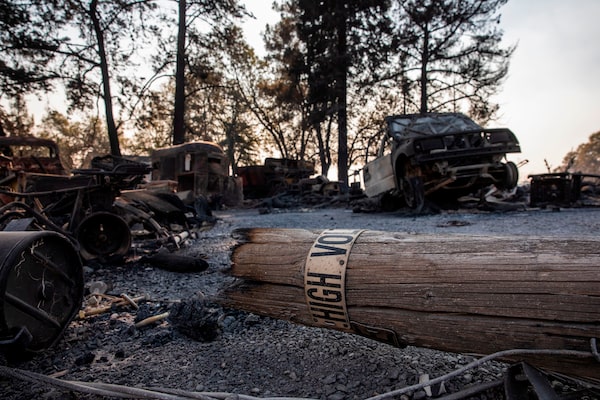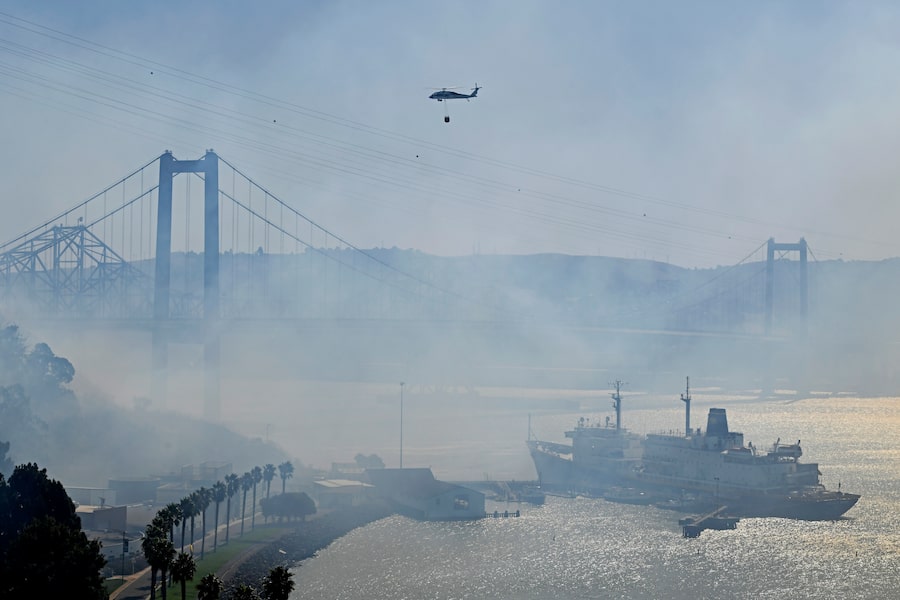
Simi Valley, Calif., Oct. 30: The Easy Fire spreads near a ranch on Tierra Rejada Road near the Ronald Reagan Presidential Library.Frederic J. BROWN/AFP via Getty Images
The latest
- Californians got a final blast of hot, dry Santa Ana winds on Thursday as two new wildfires broke out in the Los Angeles area. Much of Los Angeles and Ventura counties remained under a National Weather Service red flag warning of extreme fire danger through Thursday evening because of bone-dry humidity and the chance of winds gusting to 112 kilometres an hour in the mountains.
- Pacific Gas & Electric Co., which has staged three sweeping blackouts this week, restored power to hundreds of thousands of people Wednesday and expected to have it back for the others sometime Thursday. The utility, whose aging equipment was blamed for the destructive Camp Fire in 2018, has faced rising public anger over its desperate efforts to prevent its equipment from triggering more fires this season.
- Northern Californians, threatened by the much larger Kincade Fire, been getting used to an annual exodus in recent years as destructive blazes become the new normal in the state. California officials told The Globe and Mail’s Tamsin McMahon that previous fire seasons have improved firefighters’ tactics and they were better prepared for this year.
Where the fires are
Firefighters have been working all week to contain more than 300 wildfires that erupted in just 24 hours over the weekend. But some fires were too large to easily control, and others have brought devastation to Los Angeles and its environs. You can check the California forestry department’s latest map of the fires here.
The largest blaze so far is the Kincade Fire in Sonoma County north of San Francisco, which, as of Thursday morning, had burned nearly 77,000 acres and was 45 per cent contained. Utility Pacific Gas & Electric Co. acknowledged last week that the Kincade Fire broke out near a damaged PG&E transmission tower at about the time a live high-voltage line carried by that tower malfunctioned.
In Los Angeles, the Getty Fire (named for its proximity to the Getty Museum) forced evacuations in Brentwood, Pacific Palisades and other neighbourhoods. That fire was sparked when strong winds drove a tree branch into a power line and caused it to arc, the state Department of Water and Power says. And in nearby Simi Valley, the Easy Fire erupted Wednesday morning and came within metres of the Ronald Reagan Presidential Library.
A satellite image taken by the National Oceanic and Atmospheric Administration shows heavy smoke coming out from the wildfires of California on Oct. 27.NOAA/NOAA via REUTERS
Where the power’s out, and why
Millions of Californians get their power from PG&E, whose equipment malfunctions have been blamed for several of the fires that have destroyed homes and killed scores of people in recent years. The company is facing billions of dollars in claims that drove it into bankruptcy this past January.
This year, it’s tried to contain the risk of more fires by shutting off large areas of the state’s power grid when fire-provoking winds are expected. PG&E’s latest blackout, its third so far, started Tuesday and affected 605,000 customers – about 1.5 million people – in 30 counties. Some of those people had never had electricity restored after the previous round of blackouts, which shut power to more than 2.5 million people starting on Saturday.
PG&E’s drastic measures have been sharply criticized by Governor Gavin Newsom, who has argued that corporate greed and mismanagement kept PG&E from upgrading its infrastructure while wildfire hazards have steadily worsened over the past decade. State regulators are also opening a formal investigation of whether utilities broke rules by shutting off the power. PG&E president Bill Johnson said Tuesday he agrees with a suggestion from the governor that the company credit its customers, but he said details still need to be hammered out.

Healdsburg, Calif., Oct. 28: A fallen PG&E utility pole lays on a property burned during the Kincade Fire along Highway 128.PHILIP PACHECO/AFP via Getty Images
What the Santa Ana winds are doing
Southern California’s fires were intensified again on Tuesday night by the Santa Ana winds, gusts of hot and dry air from the mountains to the coast. Red flag warnings of extreme fire danger were issued for much of Southern California into Thursday, with gusts up to 120 kilometres an hour possible in some areas. With no rain and more wind in the forecast, the coming days could be grim.
Why does this keep happening?
Human-induced climate change threatens to make the world’s wildfires more destructive and start earlier and end later in the year. In California, recent wildfire seasons have been particularly harsh because large parts of the state have been in varying conditions of drought or abnormally dry conditions throughout the 2010s.
But other human factors make the risks even higher: From 1992 to 2012, 84 per cent of fires in the United States were started by vehicles, campfires, arson or other human factors, according to a University of Colorado study from 2017. Urban sprawl plays an important role too. Researchers have warned that cities across the United States have continued to grow unchecked into fire-prone grassland or forest over recent decades. The problem is particularly acute in California, which has some of the nation’s highest home prices and where developing outward can seem attractive to municipalities in need of more affordable housing and property-tax income.
California’s changing climate at a glance

longer seasons and
more fires in the west
Per cent change in burnt area in Western U.S.
Over 1973–1982 average
Five forest areas
North. Rockies
Northwest
Sierra Nevada
1983-1992
Southwest
1993-2002
2003-2012
South. Rockies
-1,000
0
1,000
3,000
5,000%
Fire season length in Western U.S.
Annual time between first and last large-fire discovery
and last fire declared under control
400
Last
control
300
Last
discovery
Day of year
200
First
discovery
100
0
1970
1980
1990
2000
2010
‘Increasing western U.S. forest wildfire
activity: sensitivity to changes in the timing
of spring,’ Anthony LeRoy Westerling Sierra
Nevada Research Institute, Univ. of California

longer seasons and
more fires in the west
Per cent change in burnt area in Western U.S.
Over 1973–1982 average
Five forest areas
Northern Rockies
Northwest
Sierra Nevada
1983-1992
Southwest
1993-2002
2003-2012
Southern Rockies
5,000%
-1,000
0
1,000
2,000
3,000
4,000
Fire season length in Western U.S.
Annual time between first and last large-fire discovery
and last fire declared under control
400
Last
control
300
Last
discovery
Day of year
200
First
discovery
100
0
1970
1980
1990
2000
2010
‘Increasing western U.S. forest wildfire activity:
sensitivity to changes in the timing of spring,’
Anthony LeRoy Westerling Sierra Nevada Research
Institute, University of California

longer seasons and more fires in the west
Per cent change in burnt area in Western U.S.
Over 1973–1982 average
Five forest areas
Northern Rockies
Northwest
Sierra Nevada
1983-1992
Southwest
1993-2002
2003-2012
Southern Rockies
5,000%
-1,000
0
1,000
2,000
3,000
4,000
Fire season length in Western U.S.
Annual time between first and last large-fire discovery and last fire
declared under control
400
Last
control
300
Last
discovery
Day of year
200
First
discovery
100
0
1970
1980
1990
2000
2010
‘Increasing western U.S. forest wildfire activity: sensitivity to changes in the
timing of spring,’ Anthony LeRoy Westerling Sierra Nevada Research Institute,
University of California
Compiled by Globe staff
Associated Press and Reuters, with a report from Tamsin McMahon
Our Morning Update and Evening Update newsletters are written by Globe editors, giving you a concise summary of the day’s most important headlines. Sign up today.












